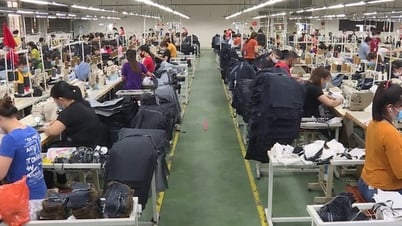Citing the fact that Thailand and Malaysia once had rapid labor productivity growth, but these two countries have not been able to maintain it, an economic expert from the United Nations Development Program (UNDP) in Vietnam warned that Vietnam needs to avoid the middle-income trap.
Discussing about increasing labor productivity at the National Assembly's 2023 Socio-Economic Forum on the morning of September 19, Mr. Jonathan Pincus, Senior International Economist of UNDP in Vietnam, made many recommendations for Vietnam.

Mr. Jonathan Pincus, Senior International Economist of UNDP in Vietnam
Mr. Jonathan Pincus said that currently in the world, there are only about 11 countries that can maintain productivity growth in the long term, of which the US is the leading country and most of the countries are in Europe.
What these countries have in common is that they are successful exporters, taking advantage of foreign demand to increase the scale of production in both industrial and agricultural sectors.
In Southeast Asia, Thailand and Malaysia had experienced rapid productivity growth. However, these two countries failed to maintain their productivity growth after the Asian financial crisis.
"These countries failed to upgrade their development policies when they reached middle-income levels, but continued to pursue growth policies based on low-cost exports; leading to no innovation to upgrade technology and upgrade the capacity of domestic manufacturing industries," said Mr. Jonathan Pincus.
According to the UNDP expert, Vietnam is a middle-income country that has achieved admirable growth over a period of time. The question is whether Vietnam will fall into the middle-income trap like the above countries. To avoid this, according to him, the key issue is to succeed in building a national innovation system.
Vietnam spends too little and too widely on research and development. There is low coordination between the central and local levels in research and development investment. Investment is spread out across too many agencies, ministries, and sectors and not focused on key sectors. Many small projects limit the impact of investment.
Notably, UNDP experts also pointed out two problems in Vietnam's investment in research and development: spending too little and spending too widely. Low coordination between the central and local levels in investment in research and development. Investment is spread out among too many agencies, ministries, and sectors and not focused on key sectors. Many small projects limit the impact of investment.
Mr. Jonathan Pincus also recommended that, in the context of businesses interested in investing in Vietnam, they need to prepare better to take advantage of this opportunity and upgrade their capacity. Vietnam has many international students studying in developed countries, many science and technology talents need to be encouraged to return to institutes and schools in Vietnam to take advantage of this human resource.
Agreeing with this view of the UNDP expert, Mr. Nguyen Duc Hien, Deputy Head of the Central Economic Committee, said that the process of increasing productivity needs to be carried out continuously, without neglect, and needs to focus on the export market for sustainable development. There needs to be a big push for science and technology, innovation, and appropriate investment in higher education.
Withdrawing social insurance at one time is a "tormenting reality"

Speakers at the roundtable discussion on increasing labor productivity
According to Mr. Hien, to create peace of mind for workers, social insurance policies must be adjusted. Recently, the issue of increasing one-time social insurance withdrawals has received much attention, showing the need to amend and supplement related laws.
Regarding more information about social insurance policies, Deputy Minister of Labor, Invalids and Social Affairs Nguyen Van Hoi shared that "the issue of withdrawing social insurance at one time is a very troubling reality". In the period 2016 - 2022, the number of people withdrawing social insurance at one time reached 3.5 million people...
According to Mr. Hoi, the number of people who withdraw social insurance at one time often falls into the case of paying for less than 5 years (70%). The reason is that workers do not fully realize the role of social insurance in ensuring social security throughout life, partly due to the difficult circumstances of workers...
Leaders of the Ministry of Labor, Invalids and Social Affairs also said that to reduce this situation, in addition to propaganda, there should be policies to increase the attractiveness of social insurance; temporary support policies for workers in difficult circumstances...
From the perspective of examination, Mr. Dang Thuan Phong, Vice Chairman of the National Assembly's Social Committee, said that the revised Social Insurance Law project had been examined by the committee on the content of one-time withdrawal of social insurance at the recent 10th session.
However, there are still many different opinions on this content in the draft law. Currently, the Government has presented two options for withdrawing social insurance at one time. The viewpoint of the reviewing agency is that regardless of the option chosen, it must ensure long-term social security for workers.
According to the Vice Chairman of the National Assembly's Social Committee, in addition to the direct solution of amending the law, there are indirect solutions such as credit mechanisms, policies to ensure stable employment... to meet the requirements and solve the problem of withdrawing social insurance at one time at present.
thanhnien.vn




![[Photo] Prime Minister Pham Minh Chinh chairs a meeting of the Steering Committee for key projects in the transport sector.](https://vphoto.vietnam.vn/thumb/1200x675/vietnam/resource/IMAGE/2025/5/10/0f4a774f29ce4699b015316413a1d09e)

































































































Comment (0)